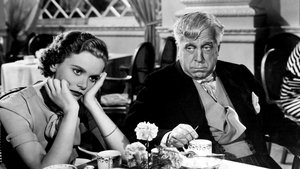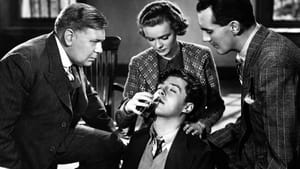Contact: [email protected]
Video Sources 0 Views

Synopsis
[ez-toc]




Introduction
In the ever-evolving landscape of cinema, where the golden age of black and white films stands as a testament to the origins of storytelling, one particular masterpiece has recently experienced a resurgence in vibrant color. “Young and Innocent Colorized” (1937), directed by the legendary Alfred Hitchcock, has been thrust into the modern spotlight through the controversial yet intriguing process of colorization. This article delves into the nuances of this cinematic endeavor, exploring the actors, the narrative, critical reception, and the transformative impact of colorization on a classic.
Read Media File Transfer Agreement: Terms and Conditions
Read FAQ
Brief Overview of “Young and Innocent Colorized” (1937)
“Young and Innocent Colorized” follows the gripping journey of Robert Tisdall, played by Derrick deMarney, a young man wrongfully accused of murder. Teaming up with Erica Burgoyne, portrayed by Nova Pilbeam, the pair embarks on a suspenseful quest to clear Robert’s name. Hitchcock’s signature suspense and mystery elements are masterfully woven into the fabric of the narrative, making it a quintessential example of the director’s early work.
Significance of Colorizing Old Movies
The decision to colorize “Young and Innocent Colorized” sparks discussions about the intersection of tradition and innovation in the film industry. Colorization, a process where black and white films are digitally transformed into color, has been a contentious practice. Some view it as a way to breathe new life into classic movies, making them more accessible to modern audiences, while purists argue that it jeopardizes the artistic integrity of the original work.
Alfred Hitchcock, renowned for his unique cinematic style, adds an interesting dimension to this debate. Known for his meticulous use of black and white cinematography to create atmosphere and suspense, Hitchcock’s films are revered for their visual storytelling. The colorization of “Young and Innocent Colorized” poses a challenge to the purist perspective but also opens doors to a fresh perspective on Hitchcock’s genius.
The Story and Style of “Young and Innocent Colorized”
Synopsis of the Film
“Young and Innocent Colorized” unfolds as a gripping tale of innocence entangled in a web of suspense and mistaken identity. Robert Tisdall becomes the prime suspect in a murder case, leading him and Erica Burgoyne on a thrilling quest to uncover the truth. As the narrative unravels, Hitchcock skillfully introduces twists and turns, keeping audiences on the edge of their seats.
Key Themes: Innocence, Suspense, Identity
The film’s themes revolve around the fragility of innocence in the face of adversity and the relentless pursuit of justice. Hitchcock’s mastery lies in his ability to infuse suspense into every frame, creating an atmospheric tension that lingers throughout the film. The theme of identity, both mistaken and concealed, adds layers to the narrative, showcasing Hitchcock’s fascination with psychological complexity.
Cinematic Techniques
Hitchcock’s cinematic techniques elevate “Young and Innocent Colorized” beyond a mere murder mystery. The use of light and shadow, innovative camera angles, and suspenseful pacing contribute to the film’s enduring legacy. The director’s signature style, often referred to as the “Hitchcock touch,” is palpable in every frame, solidifying his status as a pioneering force in cinema.
Colorization: Revitalizing Classic Films for Modern Audiences
Definition and History of Colorization
Colorization, introduced in the 1980s, aimed to update black and white films for contemporary audiences. The process involves digitally adding color to each frame, providing a modern viewing experience. Initially met with resistance, colorization has become a common practice, raising questions about its impact on the original artistic intent.
Pros and Cons of Colorizing Old Films
The debate surrounding colorization hinges on the balance between accessibility and artistic integrity. While colorization attracts new audiences and introduces classic films to younger generations, it risks altering the visual language carefully crafted by directors. Critics argue that the removal of the black and white aesthetic dilutes the intended impact, overshadowing the nuances of light and shadow.
Impact on Audience Engagement and Perception
Colorization’s impact on audience engagement is a subject of constant exploration. Some argue that color brings new life to old films, making them more relatable to contemporary viewers. Others contend that the removal of black and white limits the viewer’s ability to appreciate the director’s original vision. As we examine “Young and Innocent Colorized,” we delve into the complexities of this artistic dilemma.
Examples from Other Colorized Works
To understand the broader context, examining other colorized films is crucial. Notable examples include “It’s a Wonderful Life” and “Casablanca,” where colorization received mixed responses. These cases serve as cautionary tales and valuable insights into the delicate balance between preservation and adaptation in the film industry.
The Making of “Young and Innocent Colorized”: Behind the Scenes of a Hitchcock Masterpiece
Overview of Alfred Hitchcock’s Career
Before we immerse ourselves in the making of “Young and Innocent,” a brief overview of Hitchcock’s career is essential. The director’s early works, such as “The 39 Steps” and “The Lady Vanishes,” established him as a master of suspense. Hitchcock’s meticulous attention to detail and innovative storytelling paved the way for “Young and Innocent.”
Behind-the-Scenes Information
The production of “Young and Innocent Colorized” faced its share of challenges. Hitchcock’s demand for perfection, coupled with a tight budget, created a pressure cooker of creativity. The director’s collaboration with cinematographer Bernard Knowles, known for his groundbreaking work in black and white cinematography, added a layer of complexity to the film’s visual language.
Noteworthy is the iconic tracking shot across a crowded dance floor, showcasing Hitchcock’s knack for inventive camerawork. As we peek behind the curtain, we gain a deeper appreciation for the meticulous craftsmanship that went into creating this suspenseful masterpiece.
Analyzing the Success of “Young and Innocent Colorized” as a Colorized Remake
Relevance in Hitchcock’s Filmography
“Young and Innocent Colorized” holds a distinctive place in Hitchcock’s filmography. While not as celebrated as some of his later works, the film serves as a crucial stepping stone in the director’s evolution. Its exploration of innocence, suspense, and identity laid the groundwork for themes that would become synonymous with Hitchcock’s name.
Impact on the Thriller Genre
As we evaluate the success of the colorized remake, it is essential to consider its impact on the thriller genre. “Young and Innocent Colorized” showcases the director’s early experimentation with suspense, setting the stage for Hitchcock’s later masterpieces. The colorization treatment introduces the film to a new generation of viewers, potentially revitalizing interest in classic thrillers.
Evaluation of Colorization
Critics and audiences alike may question the decision to colorize “Young and Innocent Colorized.” Does it enhance or detract from Hitchcock’s vision? The answer lies in the delicate balance between preserving the original and adapting it for a modern audience. Colorization, when executed with care and respect for the source material, can serve as a bridge between generations, allowing timeless stories to transcend the limitations of their era.
The Legacy of “Young and Innocent Colorized”: From 1937 to the Present Day
Initial Reception and Later Reappraisal
Upon its release in 1937, “Young and Innocent Colorized” garnered positive reviews, with particular praise for its suspenseful narrative and inventive camerawork. However, over the years, the film fell into relative obscurity compared to Hitchcock’s more iconic works. The decision to colorize “Young and Innocent Colorized” offers a chance for a reappraisal, inviting audiences to rediscover a hidden gem in the director’s oeuvre.
Release and Reception of Colorized Versions
The release of colorized versions of classic films often stirs controversy. Die-hard fans and cinephiles may resist the alteration of beloved works, fearing the loss of the original artistic intent. Yet, colorization serves a dual purpose – it introduces classics to a new audience while sparking renewed interest among those familiar with the original black and white versions.
Audience Response
The reception of colorized versions depends largely on audience expectations. Some embrace the opportunity to see familiar stories in a new light, while others approach colorization with skepticism. “Young and Innocent Colorized” provides a case study in navigating this delicate balance, showcasing the potential for colorization to breathe new life into forgotten treasures.
Preserving Film History: The Importance of Embracing Both the Original and Colorized Versions
Discussion on Film Preservation
Preserving film history requires a delicate dance between honoring the original and adapting to evolving tastes. Black and white films, with their timeless elegance, offer a glimpse into the past, capturing the essence of a bygone era. It is crucial to acknowledge the historical significance of these originals, understanding their contribution to the cinematic tapestry.
Acknowledging Artistic Choice
The debate over colorization underscores the importance of recognizing artistic choice. While purists advocate for the preservation of the original black and white aesthetic, others argue for the relevance of adapting classics for contemporary audiences. By embracing both versions, we strike a balance that respects the director’s vision while acknowledging the evolving landscape of filmmaking.
Rediscovering “Young and Innocent” Through a Modern Lens
Relevance of Old Films in the Digital Age
In the digital age, where special effects and CGI dominate the screen, the allure of old films lies in their simplicity and authenticity. “Young and Innocent,” despite its age, remains a relevant exploration of human nature, suspense, and justice. As we rediscover this classic through a modern lens, we unravel the timelessness of Hitchcock’s storytelling.
Continued Influence on Modern Filmmakers
Hitchcock’s influence extends beyond his era, resonating with contemporary filmmakers. “Young and Innocent” serves as a blueprint for suspenseful storytelling, inspiring directors to craft narratives that stand the test of time. As we explore the film’s continued impact, we witness the enduring legacy of a director whose vision transcends generations.
Should You Watch “Young and Innocent” (1937) in Color?
Classic Movie Recommendation
In the final analysis, the question arises – should you watch “Young and Innocent” in color? The answer depends on your perspective and appreciation for cinematic history. Purists may opt for the original black and white version, savoring the film in its intended form. However, for those curious about the colorized rendition, it offers a unique opportunity to experience a classic through a contemporary lens.
Personal Recommendation
As a film reviewer and editor, my personal recommendation is to explore both versions. Start with the original black and white for a glimpse into Hitchcock’s mastery of light and shadow. Then, venture into the colorized adaptation, appreciating it as a reinterpretation rather than a replacement. This dual experience allows you to appreciate the film’s evolution and the ongoing dialogue about the preservation of cinematic treasures.
Conclusion
“Young and Innocent” (1937) emerges as a captivating chapter in Alfred Hitchcock’s illustrious career, offering a tantalizing blend of suspense, innocence, and mistaken identity. The decision to colorize this classic sparks debates about the intersection of tradition and innovation in filmmaking. As we navigate the intricacies of colorization, we uncover the delicate balance between preserving the original and adapting for modern audiences.
In the ever-evolving landscape of cinema, “Young and Innocent” stands as a testament to the enduring power of storytelling. Whether experienced in its original black and white form or through the lens of colorization, the film invites audiences to explore the nuanced genius of Alfred Hitchcock. As we bridge the gap between old and new, “Young and Innocent” remains a timeless journey into the heart of suspense, beckoning viewers to rediscover a cinematic gem in vivid hues.













